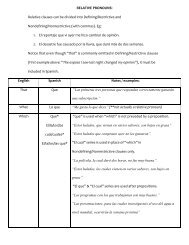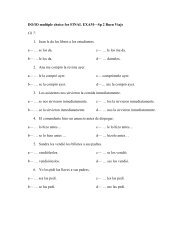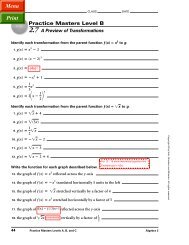MASSACHUSETTS MATHEMATICS LEAGUE OCTOBER 2004 ...
MASSACHUSETTS MATHEMATICS LEAGUE OCTOBER 2004 ...
MASSACHUSETTS MATHEMATICS LEAGUE OCTOBER 2004 ...
Create successful ePaper yourself
Turn your PDF publications into a flip-book with our unique Google optimized e-Paper software.
<strong>MASSACHUSETTS</strong> <strong>MATHEMATICS</strong> <strong>LEAGUE</strong><br />
FEBRUARY 2006<br />
ROUND 1 ALGEBRA 2: ALGEBRAIC FUNCTIONS<br />
ANSWERS<br />
A)_______________<br />
B)_______________<br />
C)_______________<br />
A) If f(x) = 2x 2 + 1, express f(2y 2 + 1) as a simplified expression in terms of y.<br />
B) Suppose G(x) = 2x 2 and F(x) = 1 – 3x. Find all x for which<br />
F(G(x)) – G(F(x)) = x.<br />
C) Given h ( x)<br />
= 2x<br />
+ 1, and g( x)<br />
= 3 − 2x<br />
, find all x for which<br />
h<br />
( x)<br />
g<br />
h(<br />
x)<br />
⋅ g(<br />
x)<br />
( x)<br />
=<br />
h(<br />
x)<br />
+ g(<br />
x)<br />
− 1<br />
1<br />
+ −<br />
.
<strong>MASSACHUSETTS</strong> <strong>MATHEMATICS</strong> <strong>LEAGUE</strong><br />
FEBRUARY 2006<br />
ROUND 2 ELEMENTARY NUMBER THEORY<br />
ANSWERS<br />
A)_______________<br />
B)_______________<br />
C) ( ______, ______ )<br />
A) If abc is a three digit prime, find the sum of the second largest prime factor and<br />
the second smallest prime factor of the six digit number abcabc.<br />
B) If A © B is defined as the sum of all composite numbers strictly between A and B, that is,<br />
including neither A nor B, evaluate:<br />
(15 © 21) © (28 © 33)<br />
B) If x and y are integers satisfying 2xy – 4x – y – 1 = 0, which ordered pair (x, y) is furthest<br />
from the origin?
<strong>MASSACHUSETTS</strong> <strong>MATHEMATICS</strong> <strong>LEAGUE</strong><br />
FEBRUARY 2006<br />
ROUND 3 TRIG: IDENTITIES & INVERSE FUNCTIONS<br />
ANSWERS<br />
A) Y = ____________<br />
B) _______________<br />
C) _______________<br />
A) Suppose Arctan( x ) = d, where 0° < d < 90°. If d = Arcsec( Y ), express Y in terms of x.<br />
B) Simplify<br />
sin θ 1+<br />
cosθ<br />
+ to obtain a single trigonometric function of θ .<br />
2(1 + cosθ<br />
) 2sinθ<br />
C) If sin( 4θ ) is written in the form A sinθ<br />
cosθ<br />
( B + C sin 2<br />
θ ) for integers A, B and C, find<br />
2<br />
A + BC<br />
.<br />
`
<strong>MASSACHUSETTS</strong> <strong>MATHEMATICS</strong> <strong>LEAGUE</strong><br />
FEBRUARY 2006<br />
ROUND 4 ALGEBRA ONE: WORD PROBLEMS<br />
ANSWERS<br />
A)______________<br />
B)___________mins<br />
C)_______________<br />
A) I have a mixture of quarters and Sacagawea dollar coins the same size.<br />
I gave $16.50 worth of these coins to a teller, but he mistakenly counted<br />
3 of the quarters as dollars. If he credited me X cents for these coins and<br />
the minimum number of coins I could have given the teller is K,<br />
find the numeric value of X + K.<br />
B) I jog at 12 feet per second and my little sister jogs at a constant slower rate.<br />
If we run in opposite directions on a quarter mile track, we pass each other<br />
every minute. If we run in the same direction, how many minutes will it<br />
take me to lap her? (Recall: 1 mile = 5280 feet!)<br />
C) A chemist adds 20 liters of an alcohol and water solution that is<br />
30% alcohol to 10 liters of an original solution of alcohol and water.<br />
He finds the percentage of alcohol in the resulting mixture is 6 percentage<br />
points higher than in the original solution.<br />
What was the percentage of alcohol of the original solution?
<strong>MASSACHUSETTS</strong> <strong>MATHEMATICS</strong> <strong>LEAGUE</strong><br />
FEBRUARY 2006<br />
ROUND 5 GEOMETRY: CIRCLES<br />
***** NO CALCULATORS ON THIS ROUND ****<br />
ANSWERS<br />
A)_______________<br />
B)_______________<br />
C)_______________<br />
A) A chord of length 96 cm is 20 cm from the center of the circle.<br />
How far is the midpoint of the chord from the furthest point on the circle?<br />
B) Two chords AB and CD intersect at E. If AE = 5x – 3, CE = 3x – 1, BA = 6x – 2,<br />
and DC = 5x – 1, find all possible lengths for AE.<br />
C) In the dagram (not to scale) PA is tangent to the circle with center O.<br />
PO = 7 7 , PD = DE and AP = 7 6 . Find the exact area of sector ODE.<br />
A<br />
P<br />
D<br />
B<br />
O<br />
C<br />
E
<strong>MASSACHUSETTS</strong> <strong>MATHEMATICS</strong> <strong>LEAGUE</strong><br />
FEBRUARY 2006<br />
ROUND 6 ALGEBRA 2: SEQUENCES & SERIES<br />
ANSWERS<br />
A)_________minutes<br />
B)_______________<br />
C)_______________<br />
A) Sal gets 4 hours of homework every school night. On day 1 he is exceptionally motivated<br />
and does all his homework. However, on each successive school night he does only half as<br />
much homework as he did on the previous school night. At the end of the school year<br />
(180 days) to the nearest minute, how much total homework will Sal have done?<br />
B) For an arithmetic sequence a, we find a<br />
2006<br />
is twice a<br />
<strong>2004</strong><br />
and a<br />
2006<br />
is 500 more than three<br />
times a<br />
2000<br />
. Find a<br />
2005<br />
.<br />
C) The sum of the first three terms of a geometric series is 296, while the infinite sum is<br />
80 less than twice that amount. Find the fifth term of the series.
<strong>MASSACHUSETTS</strong> <strong>MATHEMATICS</strong> <strong>LEAGUE</strong><br />
FEBRUARY 2006<br />
ROUND 7: TEAM QUESTIONS<br />
ANSWERS<br />
A)_______________ D)______________<br />
B)_______________ E)_______________<br />
C)_____________°_ F)_______________<br />
A) Suppose<br />
2x −1<br />
−<br />
f ( x)<br />
= For what values of x does 2 ⋅ f ( x)<br />
⋅ f<br />
1 ( x)<br />
= 2?<br />
x − 3<br />
B) Suppose m and n are twin primes (i.e. primes differing by 2) and suppose the digits used to form m and<br />
n are distinct. If the smallest such pair of numbers and the largest such pair of number are all added<br />
together, what is the sum?<br />
34<br />
C) In ∆ABC, ∠B = csc −1 ( ) and ∠A = tan − 1 (0.25). Find m∠C in degrees.<br />
3<br />
D) I am half as old as my mother was when my brother was twelve years younger than I am now.<br />
My brother was born when my mother was 26. If the sum of my brother’s and my own current<br />
ages is 36, how old was my mother when I was born?<br />
D<br />
E) In the diagram at the right, m∠DCB = 30°,<br />
AC = 4, IC = 6 and BC = 18. The exact positive difference<br />
between the distances of the two chords from the center of the<br />
circle is a − b c for integers a, b, and c.<br />
2<br />
Evaluate b c − a .<br />
I<br />
A<br />
C<br />
B<br />
F) T n = 3n +2. For some integers j and k , j > k > 6 ,<br />
T k will be the geometric mean between T 6 and T j .<br />
Find the smallest possible value of the sum j + k.
<strong>MASSACHUSETTS</strong> <strong>MATHEMATICS</strong> <strong>LEAGUE</strong><br />
FEBRUARY 2006 ANSWERS<br />
Round 1:Algebraic Functions<br />
A) 8y 4 + 8y 2 + 3 B) 1/8, 1/3 C) ½<br />
Round 2: Elementary Number Theory<br />
A) 24 B) 286 C) (1, 5)<br />
Round 3: Trig – Identities and Inverse Functions<br />
A) x + 1<br />
B) csc θ<br />
C) 14<br />
Round 4: Algebra 1 – Word Problems<br />
A) 1896 B) 11 C) 21%<br />
Round 5: Geometry - Circles<br />
A) 72 B) 2 or 12 C) 49 π<br />
3<br />
Round 6: Algebra 2 – Sequences and Series<br />
A) 480 B) 150 C) 40.5<br />
Team Round<br />
A) 1, –1 B) 128 C) 135°<br />
D) 34 E) 280 F) 57
<strong>MASSACHUSETTS</strong> <strong>MATHEMATICS</strong> <strong>LEAGUE</strong><br />
FEBRUARY 2006 BRIEF SOLUTIONS<br />
Round One:<br />
A. f (2y 2 + 1) = 2(2y 2 + 1) 2 + 1 = 2(4y 4 + 4y 2 + 1) + 1 = 8y 4 + 8y 2 + 3 .<br />
B. G(F(x)) = 2(1 – 3x) 2 = 18x 2 – 12x + 2. F(G(x)) = 1 – 6x 2 . Substitute to get<br />
24x 2 – 11x + 1 = x, so (8x – 1)(3x – 1) = 0.<br />
C. h -1 (x) = ½ x – ½ ; g -1 (x) = – ½ x + 1 ½ so h -1 (x) + g -1 (x) = 1. h(x) + g(x) = 4. h(x)⋅g(x) =<br />
– 4x 2 + 4x + 3. If 1 = (– 4x 2 + 4x + 3)/4 then 4x 2 – 4x + 1 =<br />
(2x – 1) 2 = 0.<br />
Round Two:<br />
A. abcabc = abc (1001) = abc(11)(7)(13). 13 + 11 = 24.<br />
B. 15©21 = 16 + 18 + 20 = 54; 28©33 = 30 + 32 = 62 ;<br />
54©62 = 55 + 56 + 57 + 58 + 60 = 286<br />
4x<br />
+ 1 2(2x<br />
−1)<br />
+ 3<br />
C. 2xy – y = 4x +1 so y = =<br />
so 2x – 1 is a factor of 3 (±1 or ±3).<br />
2x<br />
−1<br />
(2x<br />
−1)<br />
Thus, x must be 0, ±1 or 2. This yields the ordered pairs (1, 5), (0, -1), (2, 3) and (-1, 1).<br />
The first of these is furthest from the origin.<br />
Round Three:<br />
A. Right triangle has opposite side x , adjacent 1, hypotenuse 1+<br />
x<br />
B. Common denominator gets<br />
2<br />
2 2<br />
2<br />
sin θ + (1 + cosθ<br />
) sin θ + cos θ + 1+<br />
2cosθ<br />
2(1 + cosθ<br />
) 1<br />
=<br />
=<br />
= .<br />
2sinθ<br />
(1 + cosθ<br />
) 2sinθ<br />
(1 + cosθ<br />
) 2sinθ<br />
(1 + cosθ<br />
) sinθ<br />
C.<br />
2<br />
2<br />
sin(2 ⋅ 2θ<br />
) = 2sin(2θ<br />
)cos(2θ<br />
) = 2(2sinθ<br />
cosθ<br />
)(1 − 2sin θ ) = 4sinθ<br />
cosθ<br />
(1 + −2sin<br />
θ ) ,<br />
so A = 4, B = 1, C = -2.<br />
Round Four:<br />
A. The absolute minimum number of coins would be 16 dollars and 2 quarters, but since<br />
there must be at least 3 quarters, we have 15 dollars and 6 quarters K = 21.<br />
The teller’s mistake credited my account 3(75) = 225 extra cents X = 1875.<br />
B. In one minute 12(60)+x(60)=1320 so sister jogs at 10 ft/sec. In same direction I gain 2<br />
ft/sec or 120 ft/minute. 1320/120 = 11.<br />
n+ 6 ( n/100)10 + .30(20)<br />
C. Original mix was n/100. = Solving, n = 21.<br />
100 30<br />
Round Five:<br />
A. Rt. triangle with radius as hypotenuse has legs of 20 and ½ (96), so hypotenuse is 52<br />
[4x(5 - 12 - 13) triangle] . 20 + 52 = 72<br />
B. (AE)(BE)=(DE)(CE), so (5x – 3)(x + 1) = (3x-1)(2x). Solve quadratic to get<br />
x = 1 or 3. Both give all positive lengths so AE = 2 or 12.<br />
C. Rt ∆POA gives OA = 7. If DE = x, x(2x) = ( 7 6 ) 2 = 294, so x = DE = 7 3<br />
Thus, m∠DOE = 120° and sector is 1/3 of the circle.
Round Six:<br />
A. HW done = 4 + 2 + 1 + …. + a geometric progression of 180 terms with r = ½.<br />
The difference between the sum of 180 terms and the sum of an infinite sequence is<br />
considerably less than 1 minute, so use a/(1 – r) 4/(1 – ½) = 8 hrs = 480 min<br />
B. a<br />
2006<br />
= a<br />
2000<br />
+ 6d<br />
= 2( a2000<br />
+ 4d)<br />
, so a2000 = −2d<br />
, while a<br />
2000<br />
+ 6d<br />
= 500 + 3a2000<br />
so<br />
a = 3d<br />
250 . Thus, − 5d<br />
=− 250 d = 50, a = 100 and<br />
2000<br />
−<br />
2000<br />
−<br />
a<br />
2005<br />
= -100 + 5(50) = 150.<br />
C. a + ar + ar 2 = 296, while a/(1 – r) = 512. a = 296/(1 + r + r 2 ) = 512(1 – r), so<br />
296/512 = (1 + r + r 2 )(1 – r) = 1 – r 3 r 3 = 1 - 296/512 = 216/512 <br />
r = 3/4 and a = 128.<br />
Team Round:<br />
A.<br />
2<br />
−1<br />
1−<br />
3x<br />
−1<br />
2x<br />
−1<br />
1−<br />
3x<br />
− 6x<br />
+ 5x<br />
−1<br />
f ( x)<br />
= so if f ( x)<br />
⋅ f ( x)<br />
= ⋅ =<br />
= 1 then 5x 2 = 5 ,<br />
2<br />
2 − x<br />
x − 3 2 − x − x + 5x<br />
− 6<br />
so x = ±1.<br />
B. Smallest such pair is 3 and 5. Largest such pair is 59 and 61. (Note that twin primes with<br />
three or more digits either share the most significant digit or the smaller has 9 as both its<br />
one and tens digit) Sum is 128.<br />
C. Draw a right triangle to find tan(B) = 3/5. tanA ⋅ tanB ⋅ tanC = tanA + tanB + tanC gives<br />
tanC = -1 OR use tangent sum identity to find tan(A + B) = 1.<br />
D. I am x years old now. “Then” my mother was 2x and my brother x –12. Thus,<br />
2x – (x – 12) = 26 x = 14. I am 14 and my brother is 22 now.<br />
My mother is 26 + 22 = 48 now and thus, 34 when I was born.<br />
E. (See diagram below) CD = AC(CB)/IC = 12; CG = .5(18) – 6 = 3. Since ∆CGJ is a<br />
30-60-90, CJ = 2 3 , so JE = .5(22) – 4 – CJ .<br />
GF = GJ + 2(JE) = 3 + 2(7 − 2 3) = 14 − 3 3 , while EF = 3JE<br />
= 7 3 − 6<br />
Difference: 20 – 10 3<br />
F.<br />
2<br />
20 (3 j + 2) = 3k<br />
+ 2 . Square and simplify to 20 j = 3k<br />
+ 4k<br />
−12<br />
which must be a multiple of 4, so k is even. (WHY?)<br />
D<br />
If we substitute k = 2n we have 3n 2 + 2n<br />
− 3 = 5 j .<br />
H<br />
G<br />
Trial and error yields n ≅ 3 mod 5 or n = 3, 8, 13, ...<br />
k = 6, 16, … Since k > 6, k = 16 and j = 41.<br />
C<br />
A<br />
J<br />
E<br />
B<br />
I<br />
F








